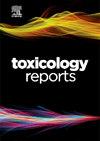Assessment of lead and cadmium exposure through olive and corn oil consumption in Gonbad-Kavus, north of Iran: A public health risk analysis
Q1 Environmental Science
引用次数: 0
Abstract
Lead and cadmium are common heavy metals in oils. This study assessed their levels in commercial and traditional olive and corn oils from Gonbad-Kavus City using graphite furnace atomic absorption spectrometry after microwave digestion. Hazard Quotient (HQ) and Hazard Index (HI) were calculated. The results from 60 oil samples showed quantifiable levels of lead and cadmium in all samples. Lead concentrations in commercial olive oil, traditional olive oil, commercial corn oil, and traditional corn oil were 13.27 ± 3.37, 17.48 ± 4.82, 19.27 ± 8.12, and 32.40 ± 6.13 μg/kg, respectively. Cadmium concentrations were 4.14 ± 0.53, 3.50 ± 0.72, 4.48 ± 1.80, and 5.77 ± 1.34 µg/kg, respectively. All lead levels were below the 80 µg/kg limit set by the Institute of Standards and Industrial Research of Iran (ISIRI). For a 70 kg person consuming 0.147 g of corn oil and 0.328 g of olive oil daily, the metals pose no risk to health over a lifetime. No health concerns were found for oils except traditional olive oil. Corn oil showed significant lead contamination. HI values for lead and cadmium in oils were below 1, indicating no non-carcinogenic health risk. MOE values for lead in traditional olive oil were below 10,000, while other oils were above, indicating no significant risk to consumers. These findings call for a review of national standards and increased monitoring of heavy metals in vegetable oils in the region.
伊朗北部Gonbad-Kavus地区通过食用橄榄油和玉米油而接触铅和镉的评估:一项公共健康风险分析
铅和镉是油类中常见的重金属。本研究利用微波消解后的石墨炉原子吸收光谱法测定了贡巴德-卡夫斯市的商业和传统橄榄油和玉米油中它们的含量。计算危害商(HQ)和危害指数(HI)。60份石油样本的结果显示,所有样本中都含有可量化的铅和镉。铅浓度在传统商业橄榄油,橄榄油,商业玉米油,和传统的玉米油13.27 ± 3.37,17.48 ± 4.82,19.27 ± 8.12,和32.40 ±6.13 μg /公斤,分别。镉浓度4.14 ± 0.53、3.50 ± 0.72,4.48 ± 1.80,和5.77 ±1.34 µg /公斤,分别。所有的铅含量都低于伊朗标准与工业研究所(ISIRI)设定的80 µg/kg的限值。对于一个体重70 公斤的人来说,每天摄入0.147 克玉米油和0.328 克橄榄油,这些金属在一生中不会对健康构成威胁。除了传统的橄榄油外,没有发现其他油有健康问题。玉米油显示出明显的铅污染。油中铅和镉的HI值低于1,表明没有非致癌的健康风险。传统橄榄油中铅的MOE值低于10,000,而其他油高于10,000,表明对消费者没有重大风险。这些发现呼吁对国家标准进行审查,并加强对该地区植物油中重金属的监测。
本文章由计算机程序翻译,如有差异,请以英文原文为准。
求助全文
约1分钟内获得全文
求助全文
来源期刊

Toxicology Reports
Environmental Science-Health, Toxicology and Mutagenesis
CiteScore
7.60
自引率
0.00%
发文量
228
审稿时长
11 weeks
 求助内容:
求助内容: 应助结果提醒方式:
应助结果提醒方式:


